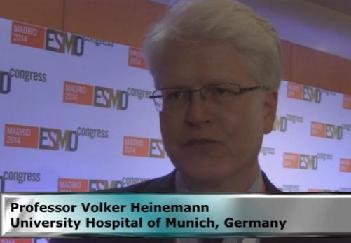Advertisment
ESMO 2014 Report: Video interview with Professor Volker Heinemann (Munich) and other delegate views.

Click ‘Read More’ for the new data delegate views on whether early tumour shrinkage is now an accepted marker in mCRC.
Is early tumour shrinkage now an accepted surrogate marker in mCRC? An interview with Volker Heinemann (Munich).
http://player.vimeo.com/video/108249006
Dr Sebastian Stintzing, of the University of Munich in Germany, presented both the final all RAS population analysis and also data from independent radiological evaluation of the objective response rate (ORR), rate of early tumour shrinkage (ETS) and depth of response (DoR) in the final RAS evaluable population in the FIRE-3 study. Overall survival in the final RAS wild-type population showed a highly significant difference of 8.1 months [HR 0.697 (95% CI 0.54-0.90); p=0.0059] between the two arms favouring cetuximab/FOLFIRI. [mOS cetuximab/FOLFIRI 33.1 months (95% CI 24.5-39.4); mOS bevacizumab/FOLFIRI 25.0 months (95% CI 23.0-28.0)].
Independent radiological evaluation showed that patients treated with cetuximab/FOLFIRI had significantly higher ORR, higher rate of ETS and greater DoR than patients treated with bevacizumab/FOLFIRI. According to Dr Stintzing, this may explain the OS advantage of cetuximab/FOLFIRI noted in patients with KRAS exon 2 wild-type tumours [2]. The FIRE-3 study analysed a total of 637 tumour samples from mCRC patients at centres in Germany and Austria. The final RAS evaluable population comprised 400 RAS wild-type samples and 75 samples with new KRAS exon 3,4 or NRAS exon 2, 3 or 4 mutations. The independent radiological review was performed on 330 patients in the final RAS wild-type population who had CT scan-evaluable tumours. In this population, the overall tumour response rate according to the RECIST 1:1 criteria [4] was 72.0% in the cetuximab/FOLFIRI arm compared with 56.1% in the bevacizumab/FOLFIRI arm (odds ratio [OR] 2.01; 95% confidence interval [CI] 1.27, 3.19; p=0.003) which was consistent with the difference in ORR observed in the KRAS exon 2 wild-type population (66.5% versus 55.6%; p=0.016). Likewise, the proportion of patients in the final RAS wild-type population who achieved ETS defined as ≥20% tumour shrinkage at six weeks was 68.2% in the cetuximab arm versus 49.1% in the bevacizumab arm (OR 2.22; 95%CI 1.41, 3.47; p=0.0005), and DoR, expressed as the percentage of maximum tumour shrinkage from baseline, was 48.9% in the cetuximab arm versus 32.3% in the bevacizumab arm (p<0.0001). ETS and DoR correlated significantly with OS and PFS in both treatment arms.
Delegate opinions on the tumour shrinkage data from FIRE 3
Richard Adams (Cardiff) and Dirk Arnold (Freiburg)
http://player.vimeo.com/video/108250804
What’s the new data from FIRE 3 on RAS wt mCRC, depth of response and early tumour shrinkage
An interview with Volker Heinemann (Munich)
http://player.vimeo.com/video/108249005
References
1. Venook, A., et al., CALGB/SWOG 80405: Phase III trial of irinotecan/5-FU/leucovorin (FOLFIRI) or oxaliplatin/5-FU/leucovorin (mFOLFOX6) with bevacizumab (BV) or cetuximab (CET) for patients (pts) with KRAS wild-type (wt) untreated metastatic adenocarcinoma of the colon or rectum (MCRC). J Clin Oncol, 2014. 32 (Suppl): p. 5s.
2. Heinemann, V., et al., FOLFIRI plus cetuximab versus FOLFIRI plus bevacizumab as first-line treatment for patients with metastatic colorectal cancer (FIRE-3): a randomised, open-label, phase 3 trial. Lancet Oncol, 2014. 15(10): p. 1065-75.
3. Dressman, D., et al., Transforming single DNA molecules into fluorescent magnetic particles for detection and enumeration of genetic variations. Proc Natl Acad Sci U S A, 2003. 100(15): p. 8817-22.
4. Eisenhauer, E.A., et al., New response evaluation criteria in solid tumours: revised RECIST guideline (version 1.1). Eur J Cancer, 2009. 45(2): p. 228-47.
5. Schwartzberg, L.S., et al., PEAK: a randomized, multicenter phase II study of panitumumab plus modified fluorouracil, leucovorin, and oxaliplatin (mFOLFOX6) or bevacizumab plus mFOLFOX6 in patients with previously untreated, unresectable, wild-type KRAS exon 2 metastatic colorectal cancer. J Clin Oncol, 2014. 32(21): p. 2240-7.
6. Van Cutsem, E., et al., Metastatic colorectal cancer: ESMO Clinical Practice Guidelines for diagnosis, treatment and follow-updagger. Ann Oncol, 2014. 25 Suppl 3: p. iii1-iii9.





